formerly eScholarship Editions


|
|
|
|
Your search for
'Cinema and Performance Arts' in subject
and
Public
in rights
found 24 book(s). | Modify Search | Displaying 1 - 20 of 24 book(s) | |
| 1. | 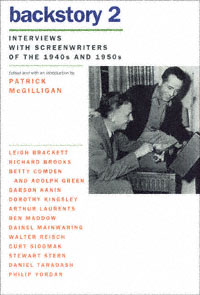 | Title: Backstory 2: interviews with screenwriters of the 1940s and 1950s Author: McGilligan, Patrick Published: University of California Press, 1997 Subjects: Cinema and Performance Arts | Theatre Publisher's Description: "Backstory" is the screenwriter's term for what happens in a plot before the screen story begins. In this companion volume to McGilligan's widely praised Backstory: Interviews with Screenwriters of Hollywood's Golden Age , fourteen studio scribes active in later decades rail and reminisce about their fifty-plus years of inventing and scripting movies. Richard Brooks, Garson Kanin and Ruth Gordon, Arthur Laurents, Ben Maddow, Stewart Stern, Daniel Taradash, and Philip Yordan are among the distinguished figures included.The 1940s were a period of transition for the motion picture industry, from an era of hope and glory and the upheavals of World War II to a postwar era of caution and confusion. The 1950s brought a great decline in the number of films produced and led to the extinction of that peculiar creature, the contract writer.The survivors of Hollywood's most productive years remain wonderfully talkative, however. In this lively collection of interviews they contribute useful writing tips, radical correctives to screen history and industry folklore, and just plain fascinating gossip. As a whole, the interviews provide a compelling biographical close-up of an entire generation of men and women whose talent, vision, and tenacity were critical to the institution we know as "Hollywood." [brief] Similar Items |
| 2. | 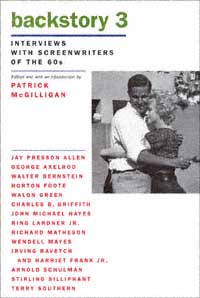 | Title: Backstory 3: interviews with screenwriters of the 1960s Author: McGilligan, Patrick Published: University of California Press, 1997 Subjects: Cinema and Performance Arts | Film | Writing Publisher's Description: The Backstory series of unique "oral histories" chronicles the lives and careers of notable Hollywood screenwriters - in their own words. Backstory: Interviews with Screenwriters of Hollywood's Golden Age focused on the early sound era and the 1930s. Backstory 2 featured Interviews with Screenwriters of the 1940s and 1950s. Backstory 3 takes up the history of American screenwriting in the 1960s, through the experiences of fourteen key scenarists. These lively interviews, conducted by Pat McGilligan and others, feature Jay Presson Allen, George Axelrod, Walter Bernstein, Horton Foote, Walon Green, Charles B. Griffith, John Michael Hayes, Ring Lardner Jr., Wendell Mayes, Irving Ravetch and Harriet Frank Jr., Arnold Schulman, Stirling Silliphant, and Terry Southern.The series has proven useful and edifying for film students, scholars, and historians, for screenwriters and other professionals, and for film buffs in general. Applauded by reviewers and named among the "100 essential film books" by a Los Angeles Times -appointed panel, it is cited often and quoted in many film histories. [brief] Similar Items |
| 3. | 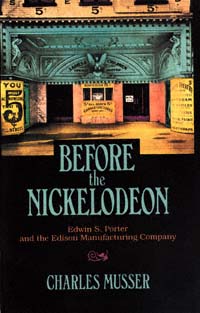 | Title: Before the nickelodeon: Edwin S. Porter and the Edison Manufacturing Company Author: Musser, Charles Published: University of California Press, 1991 Subjects: Cinema and Performance Arts | Film | United States History | Popular Culture Publisher's Description: Musser takes us into the long-forgotten world of early cinema - unexpectedly sophisticated and yet radically different from current movie-making. Focusing on Edwin S. Porter, most often remembered as the producer of The Great Train Robbery , Musser situates Porter's achievements within the vibrant c . . . [more] Similar Items |
| 4. |  | Title: Cecil B. DeMille and American culture: the silent era Author: Higashi, Sumiko Published: University of California Press, 1994 Subjects: Cinema and Performance Arts | History | Film | Women's Studies Publisher's Description: Cecil B. DeMille and American Culture demonstrates that the director, best remembered for his overblown biblical epics, was one of the most remarkable film pioneers of the Progressive Era. In this innovative work, which integrates cultural history and cultural studies, Sumiko Higashi shows how DeMille artfully inserted cinema into genteel middle-class culture by replicating in his films such spectacles as elaborate parlor games, stage melodramas, department store displays, Orientalist world's fairs, and civic pageantry. The director not only established his signature as a film author by articulating middle-class ideology across class and ethnic lines, but by the 1920's had become a trendsetter, with set and costume designs that influenced the advertising industry to create a consumer culture based on female desire. Drawing on a wealth of previously untapped material from the DeMille Archives and other collections, Higashi provides imaginative readings of DeMille's early feature films, viewing them in relation to the dynamics of social change, and she documents the extent to which the emergence of popular culture was linked to the genteel tradition. [brief] Similar Items |
| 5. | 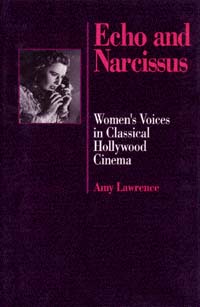 | Title: Echo and Narcissus: women's voices in classical Hollywood cinema Author: Lawrence, Amy Published: University of California Press, 1991 Subjects: Cinema and Performance Arts | Film | Women's Studies Publisher's Description: Do women in classical Hollywood cinema ever truly speak for themselves? In Echo and Narcissus , Amy Lawrence examines eight classic films to show how women's speech is repeatedly constructed as a "problem," an affront to male authority. This book expands feminist studies of the representation of women in film, enabling us to see individual films in new ways, and to ask new questions of other films.Using Sadie Thompson (1928), Blackmail (1929), Rain (1932), The Spiral Staircase , Sorry,Wrong Number , Notorious , Sunset Boulevard (1950) and To Kill a Mockingbird (1962), Lawrence illustrates how women's voices are positioned within narratives that require their submission to patriarchal roles and how their attempts to speak provoke increasingly severe repression. She also shows how women's natural ability to speak is interrupted, made difficult, or conditioned to a suffocating degree by sound technology itself. Telephones, phonographs, voice-overs, and dubbing are foregrounded, called upon to silence women and to restore the primacy of the image.Unlike the usage of "voice" by feminist and literary critics to discuss broad issues of authorship and point of view, in film studies the physical voice itself is a primary focus. Echo and Narcissus shows how assumptions about the "deficiencies" of women's voices and speech are embedded in sound's history, technology, uses, and marketing. Moreover, the construction of the woman's voice is inserted into the ideologically loaded cinematic and narrative conventions governing the representation of women in Hollywood film. [brief] Similar Items |
| 6. | 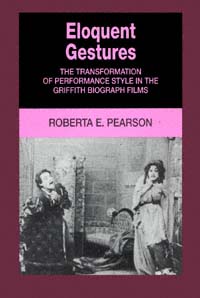 | Title: Eloquent gestures: the transformation of performance style in the Griffith Biograph films Author: Pearson, Roberta E Published: University of California Press, 1992 Subjects: Cinema and Performance Arts | Film Publisher's Description: Between 1908 and 1913, D. W. Griffith played a key role in the reformulating of film's narrative techniques, thus contributing to the creation of what we now think of as the classical Hollywood cinema. This book is the only extensive treatment of a critical period in the history of film acting: the emergence of the realistic "verisimilar" style in Griffith's biograph films. Roberta Pearson shows how Griffith gradually abandoned the deliberately affected "histrionic" acting style derived from the nineteenth-century stage. No longer did actors mime distress by raising their arms to heaven or clutching their heads - a subtle facial expression, a slight change in posture would convey a character's extreme emotions instead.Pearson makes detailed comparisons of certain Biograph films and brings a freshness to her analysis by closely examining contemporary journalistic writing, acting manuals, and the recollections of actors of the time. Her work is important for anyone interested in early cinema and performance, and it will enliven the study of American cultural history and mass communications. [brief] Similar Items |
| 7. | 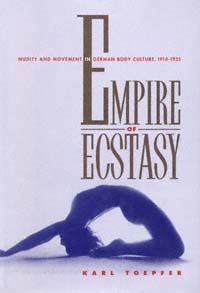 | Title: Empire of ecstasy: nudity and movement in German body culture, 1910-1935 Author: Toepfer, Karl Eric 1948- Published: University of California Press, 1997 Subjects: Cinema and Performance Arts | German Studies | Gender Studies | Dance Publisher's Description: Empire of Ecstasy offers a novel interpretation of the explosion of German body culture between the two wars - nudism and nude dancing, gymnastics and dance training, dance photography and criticism, and diverse genres of performance from solo dancing to mass movement choirs. Karl Toepfer presents this dynamic subject as a vital and historically unique construction of "modern identity." The modern body, radiating freedom and power, appeared to Weimar artists and intelligentsia to be the source of a transgressive energy, as well as the sign and manifestation of powerful, mysterious "inner" conditions. Toepfer shows how this view of the modern body sought to extend the aesthetic experience beyond the boundaries imposed by rationalized life and to transcend these limits in search of ecstasy. With the help of much unpublished or long-forgotten archival material (including many little-known photographs), he investigates the process of constructing an "empire" of appropriative impulses toward ecstasy. Toepfer presents the work of such well-known figures as Rudolf Laban, Mary Wigman, and Oskar Schlemmer, along with less-known but equally fascinating body culture practitioners. His book is certain to become required reading for historians of dance, body culture, and modernism. [brief] Similar Items |
| 8. | 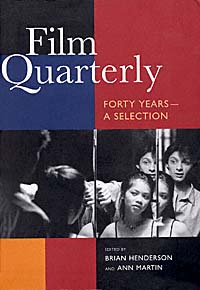 | Title: Film quarterly: forty years--a selection Author: Henderson, Brian Published: University of California Press, 1999 Subjects: Cinema and Performance Arts | Film Publisher's Description: During its forty years as a forum for scholars, filmmakers, critics, and film lovers, Film Quarterly has looked in depth at the most critical elements in the political, social, theoretical, and aesthetic history of the cinema. Once closely tied to Hollywood, the journal was investigated by the Tenney committee in 1946 and two of its board members came under fire from the House Un-American Activities Committee in 1951. After several metamorphoses, however, and with the dedicated participation of its editors, board members, and authors, the journal now stands as the oldest and most prominent journal in cinema studies, publishing film (and video and television) history, criticism, theory, analysis, interviews, and film and book reviews.Spanning the 1950s to the 1990s, Film Quarterly: Forty Years - A Selection is a collaborative effort by the past and present editors and the editorial board to celebrate and illuminate the medium that has prompted so much thought and exchange during the journal's lifetime. From articles on documentary and genre to history and technology, narrative and the avant-garde, this carefully selected collection proposes groundbreaking theoretical models, fresh approaches to individual film classics, reassessments of filmmakers' bodies of work, and discussions of new films and technologies. [brief] Similar Items |
| 9. | 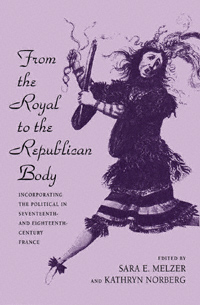 | Title: From the royal to the republican body: incorporating the political in seventeenth- and eighteenth-century France Author: Melzer, Sara E Published: University of California Press, 1998 Subjects: History | European History | French Studies | European Literature | Cinema and Performance Arts | Politics Publisher's Description: In this innovative volume, leading scholars examine the role of the body as a primary site of political signification in seventeenth- and eighteenth-century France. Some essays focus on the sacralization of the king's body through a gendered textual and visual rhetoric. Others show how the monarchy mastered subjects' minds by disciplining the body through dance, music, drama, art, and social rituals. The last essays in the volume focus on the unmaking of the king's body and the substitution of a new, republican body. Throughout, the authors explore how race and gender shaped the body politic under the Bourbons and during the Revolution. This compelling study expands our conception of state power and demonstrates that seemingly apolitical activities like the performing arts, dress and ritual, contribute to the state's hegemony. From the Royal to the Republican Body will be an essential resource for students and scholars of history, literature, music, dance and performance studies, gender studies, art history, and political theory. [brief] Similar Items |
| 10. | 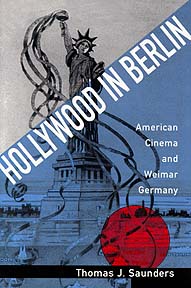 | Title: Hollywood in Berlin: American cinema and Weimar Germany Author: Saunders, Thomas J Published: University of California Press, 1994 Subjects: Cinema and Performance Arts | German Studies | Film | United States History | European History Publisher's Description: The setting is 1920s Berlin, cultural heart of Europe and the era's only serious cinematic rival to Hollywood. In his engaging study, Thomas Saunders explores an outstanding example of one of the most important cultural developments of this century: global Americanization through the motion picture.The invasion of Germany by American films, which began in 1921 with overlapping waves of sensationalist serials, slapstick shorts, society pictures, and historical epics, initiated a decade of cultural collision and accommodation. On the one hand it fueled an impassioned debate about the properties of cinema and the specter of wholesale Americanization. On the other hand it spawned unprecedented levels of cooperation and exchange.In Berlin, American motion pictures not only entertained all social classes and film tastes but also served as a vehicle for American values and a source of sharp economic competition. Hollywood in Berlin correlates the changing forms of Hollywood's contributions to Weimar culture and the discourses that framed and interpreted them, restoring historical contours to a leading aspect of cultural interchange in this century. At the same time, the book successfully embeds Weimar cinema in its contemporary international setting. [brief] Similar Items |
| 11. | 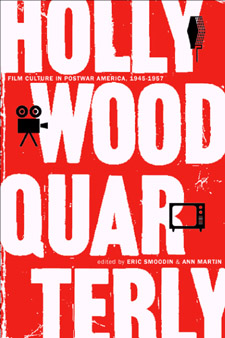 | Title: Hollywood quarterly: film culture in postwar America, 1945-1957 Author: Smoodin, Eric Loren Published: University of California Press, 2002 Subjects: Cinema and Performance Arts Publisher's Description: The first issue of Hollywood Quarterly, in October 1945, marked the appearance of the most significant, successful, and regularly published journal of its kind in the United States. For its entire life, the Quarterly held to the leftist utopianism of its founders, several of whom would later be blacklisted. The journal attracted a collection of writers unmatched in North American film studies for the heterogeneity of their intellectual and practical concerns: from film, radio, and television industry workers to academics; from Sam Goldwyn, Edith Head, and Chuck Jones to Theodor Adorno and Siegfried Kracauer. For this volume, Eric Smoodin and Ann Martin have selected essays that reflect the astonishing eclecticism of the journal, with sections on animation, the avant-garde, and documentary to go along with a representative sampling of articles about feature-length narrative films. They have also included articles on radio and television, reflecting the contents of just about every issue of the journal and exemplifying the extraordinary moment in film and media studies that Hollywood Quarterly captured and helped to create. In 1951, Hollywood Quarterly was renamed the Quarterly of Film, Radio, and Television, and in 1958 it was replaced by Film Quarterly, which is still published by the University of California Press. During those first twelve years, the Quarterly maintained an intelligent, sophisticated, and critical interest in all the major entertainment media, not just film, and in issue after issue insisted on the importance of both aesthetic and sociological methodologies for studying popular culture, and on the political significance of the mass media. [brief] Similar Items |
| 12. | 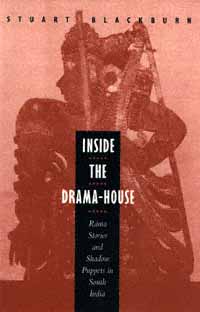 | Title: Inside the drama-house: Rama stories and shadow puppets in South India Author: Blackburn, Stuart H Published: University of California Press, 1996 Subjects: Anthropology | Asian Studies | South Asia | Cinema and Performance Arts | Hinduism Publisher's Description: Stuart Blackburn takes the reader inside a little-known form of shadow puppetry in this captivating work about performing the Tamil version of the Ramayana epic. Blackburn describes the skill and physical stamina of the puppeteers in Kerala state in South India as they perform all night for as many as ten weeks during the festival season. The fact that these performances often take place without an audience forms the starting point for Blackburn's discussion - one which explores not only this important epic tale and its performance, but also the broader theoretical issues of text, interpretation, and audience.Blackburn demonstrates how the performers adapt the narrative and add their own commentary to re-create the story from a folk perspective. At a time when the Rama story is used to mobilize political movements in India, the puppeteers' elaborate recitation and commentary presents this controversial tale from another ethical perspective, one that advocates moral reciprocity and balance.While the study of folk narrative has until now focused on tales, tellers, and tellings, this work explores the importance of audience - absent or otherwise. Blackburn's elegant translations of the most dramatic and pivotal sequences of the story enhance our appreciation of this unique example of performance art. [brief] Similar Items |
| 13. | 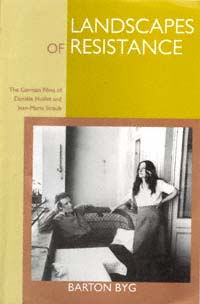 | Title: Landscapes of resistance: the German films of Danièle Huillet and Jean-Marie Straub Author: Byg, Barton 1953- Published: University of California Press, 1995 Subjects: Cinema and Performance Arts | Film | German Studies | Intellectual History Publisher's Description: Fervently admired and frequently reviled, Jean-Marie Straub and Danièle Huillet - who have lived and worked together for almost forty years - may well be the most uncompromising, not to say intransigent, filmmakers in the history of the medium. Their radical and deeply political films placed them as forerunners of the New German Cinema movement in the 1960s and influential figures in the subsequent explosion of the European avant-garde. In Landscapes of Resistance , Barton Byg fills a significant gap in modern German and European cinema studies by tracing the career of the two filmmakers and exploring their connection to German modernism, in particular their relationship to the Frankfurt School.Although they are not German themselves, Straub and Huillet have used German material as the basis for the majority of their films. They have transcribed prose by Böll and Kafka, operas by Schoenberg, and verse dramas by Holderlin. Byg explores how their work engages German culture with a critical distance and affection and confronts the artificiality of divisions between high and low culture. [brief] Similar Items |
| 14. | 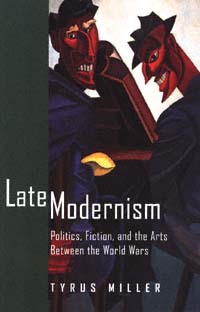 | Title: Late modernism: politics, fiction, and the arts between the world wars Author: Miller, Tyrus 1963- Published: University of California Press, 1999 Subjects: Literature | Fiction | Art Theory | Cinema and Performance Arts | Politics | Political Theory | History Publisher's Description: Tyrus Miller breaks new ground in this study of early twentieth-century literary and artistic culture. Whereas modernism studies have generally concentrated on the vital early phases of the modernist revolt, Miller focuses on the turbulent later years of the 1920s and 1930s, tracking the dissolution of modernism in the interwar years.In the post-World War I reconstruction and the worldwide crisis that followed, Miller argues, new technological media and the social forces of mass politics opened fault lines in individual and collective experience, undermining the cultural bases of the modernist movement. He shows how late modernists attempted to discover ways of occupying this new and often dangerous cultural space. In doing so they laid bare the ruin of the modernist aesthetic at the same time as they transcended its limits.In his wide-ranging theoretical and historical discussion, Miller relates developments in literary culture to tendencies in the visual arts, cultural and political criticism, mass culture, and social history. He excavates Wyndham Lewis's hidden borrowings from Al Jolson's The Jazz Singer ; situates Djuna Barnes between the imagery of haute couture and the intellectualism of Duchamp; uncovers Beckett's affinities with Giacometti's surrealist sculptures and the Bolshevik clowns Bim-Bom; and considers Mina Loy as both visionary writer and designer of decorative lampshades. Miller's lively and engaging readings of culture in this turbulent period reveal its surprising anticipation of our own postmodernity. [brief] Similar Items |
| 15. | 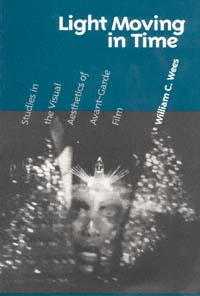 | Title: Light moving in time: studies in the visual aesthetics of avant-garde film Author: Wees, William C. (William Charles) 1935- Published: University of California Press, 1992 Subjects: Cinema and Performance Arts | Film Publisher's Description: To view a film is to see another's seeing mediated by the technology and techniques of the camera. By manipulating the cinematic apparatus in unorthodox ways, avant-garde filmmakers challenge the standardized versions of seeing perpetuated by the dominant film industry and generate ways of seeing that are truer to actual human vision.Beginning with the proposition that the images of cinema and vision derive from the same basic elements - light, movement, and time - Wees argues that cinematic apparatus and human visual apparatus have significant properties in common. For that reason they can be brought into a dynamic, creative relationship which the author calls the dialectic of eye and camera. The consequences of this relationship are what Wees explores.Although previous studies have recognized the visual bias of avant-garde film, this is the first to place the visual aesthetics of avant-garde film in a long-standing, multidisciplinary discourse on vision, visuality, and art. [brief] Similar Items |
| 16. | 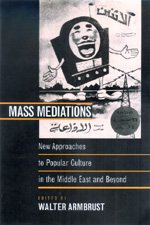 | Title: Mass mediations: new approaches to popular culture in the Middle East and beyond Author: Armbrust, Walter Published: University of California Press, 2000 Subjects: Middle Eastern Studies | Anthropology | Cultural Anthropology | Media Studies | Music | Cinema and Performance Arts Publisher's Description: Offering a stimulating diversity of perspectives, this collection examines how popular culture through mass media defines the scale and character of social interaction in the Middle East. The contributors approach popular culture broadly, with an interest in how it creates new scales of communication and new dimensions of identity that affect economics, politics, aesthetics, and performance. Reflected in these essays is the fact that mass media are as ubiquitous in Cairo and Karachi as in Los Angeles and Detroit. From Persian popular music in Beverly Hills to Egyptians' reaction to a recent film on Gamal Abdel Nasser; from postmodern Turkish novels to the music of an Israeli transsexual singer, the essays illustrate the multiple contexts of modern cultural production. The unfolding of modernity in colonial and postcolonial societies has been little analyzed until now. In addressing transnational aspects of Middle Eastern societies, the contributors also challenge conventional assumptions about the region and its relation to the West. The volume will have wide appeal both to Middle Eastern scholars and to readers interested in global and cultural studies. [brief] Similar Items |
| 17. | 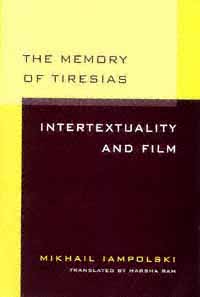 | Title: The memory of Tiresias: intertextuality and film Author: I︠A︡mpolʹskiĭ, M. B Published: University of California Press, 1998 Subjects: Cinema and Performance Arts | Literature | Popular Culture Publisher's Description: The concept of intertextuality has proven of inestimable value in recent attempts to understand the nature of literature and its relation to other systems of cultural meaning. In The Memory of Tiresias , Mikhail Iamposlki presents the first sustained attempt to develop a theory of cinematic intertextuality.Building on the insights of semiotics and contemporary film theory, Iampolski defines cinema as a chain of transparent, mimetic fragments intermixed with quotations he calls "textual anomalies." These challenge the normalization of meaning and seek to open reading out onto the unlimited field of cultural history, which is understood in texts as a semiotically active extract, already inscribed.Quotations obstruct mimesis and are consequently transformed in the process of semiosis, an operation that Iampolski defines as reading in an aura of enigma. In a series of brilliant analyses of films by D.W. Griffith, Sergei Eisenstein, and Luis Buñuel, he presents different strategies of intertextual reading in their work. His book suggests the continuing centrality of semiotic analysis and is certain to interest film historians and theorists, as well as readers in cultural and literary studies. [brief] Similar Items |
| 18. | 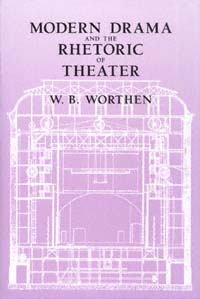 | Title: Modern drama and the rhetoric of theater Author: Worthen, William B 1955- Published: University of California Press, 1991 Subjects: Cinema and Performance Arts | Theatre | Rhetoric Publisher's Description: The history of drama is typically viewed as a series of inert "styles." Tracing British and American stage drama from the 1880s onward, W. B. Worthen instead sees drama as the interplay of text, stage production, and audience.How are audiences manipulated? What makes drama meaningful? Worthen identifies three rhetorical strategies that distinguish an O'Neill play from a Yeats, or these two from a Brecht. Where realistic theater relies on the "natural" qualities of the stage scene, poetic theater uses the poet's word, the text, to control performance. Modern political theater, by contrast, openly places the audience at the center of its rhetorical designs, and the drama of the postwar period is shown to develop a range of post-Brechtian practices that make the audience the subject of the play.Worthen's book deserves the attention of any literary critic or serious theatergoer interested in the relationship between modern drama and the spectator. [brief] Similar Items |
| 19. | 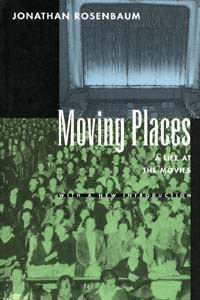 | Title: Moving places: a life at the movies Author: Rosenbaum, Jonathan Published: University of California Press, 1995 Subjects: Cinema and Performance Arts | Film | Autobiography Publisher's Description: Moving Places is the brilliant account of a life steeped in and shaped by the movies - part autobiography, part film analysis, part social history. Jonathan Rosenbaum, one of America's most gifted film critics, began his moviegoing in the 1950s in small-town Alabama, where his family owned and managed a chain of theaters.Starting in the Deep South of his boyhood, Rosenbaum leads us through a series of "screen memories," making us aware of movies as markers of the past - when and where we saw them, with whom, and what we did afterward. The mood swings easily from sensual and poignant regret to screwball exuberance, punctuated along the way by a tribute to the glamorous Grace Kelly of Rear Window , a meditation on The Rocky Horror Picture Show and its improbable audience-community, and an extended riff on Rosenbaum's encounters with On Moonlight Bay .Originally published in 1980, Moving Places is reissued now both as a companion volume to the author's latest book and as a means of introducing a new generation of film buffs to this unique, often humorous exploration of one man's life at the movies. [brief] Similar Items |
| 20. | 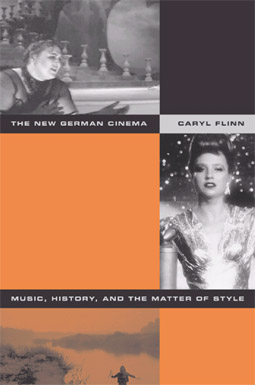 | Title: The new German cinema: music, history, and the matter of style Author: Flinn, Caryl Published: University of California Press, 2003 Subjects: Cinema and Performance Arts | German Studies | Music Publisher's Description: When New German cinema directors like R. W. Fassbinder, Ulrike Ottinger, and Werner Schroeter explored issues of identity - national, political, personal, and sexual - music and film style played crucial roles. Most studies of the celebrated film movement, however, have sidestepped the role of music, a curious oversight given its importance to German culture and nation formation. Caryl Flinn's study reverses this trend, identifying styles of historical remembrance in which music participates. Flinn concentrates on those styles that urge listeners to interact with difference - including that embodied in Germany's difficult history - rather than to "master" or "get past" it. Flinn breaks new ground by considering contemporary reception frameworks of the New German Cinema, a generation after its end. She discusses transnational, cultural, and historical contexts as well as the sexual, ethnic, national, and historical diversity of audiences. Through detailed case studies, she shows how music helps filmgoers engage with a range of historical subjects and experiences. Each chapter of The New German Cinema examines a particular stylistic strategy, assessing music's role in each. The study also examines queer strategies like kitsch and camp and explores the movement's charged construction of human bodies on which issues of ruination, survival, memory, and pleasure are played out. [brief] Similar Items |